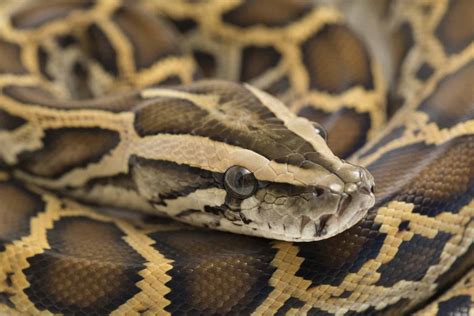
A quick response by Hawaiian authorities prevented a potential ecological disaster after an invasive python was captured on the island of Oahu. The non-native snake, a significant threat to the local ecosystem, was apprehended before it could establish itself and further endanger native species.
Honolulu, Hawaii – The Hawaii Department of Agriculture (HDOA) successfully captured a non-native reticulated python on Oahu, averting what officials described as a potential ecological crisis. The snake, discovered in a residential area, posed a significant threat to the island’s delicate ecosystem, which is particularly vulnerable to invasive species. The swift action by authorities underscores the ongoing challenges Hawaii faces in preventing the introduction and establishment of harmful non-native animals and plants.
The discovery of the python triggered an immediate response from the HDOA’s Plant Quarantine Branch. Upon receiving a report from a concerned resident, trained personnel were dispatched to the location to assess the situation and capture the snake. According to the HDOA, the reticulated python is one of the world’s longest snakes, capable of growing to over 20 feet in length. Its presence in Hawaii, where it has no natural predators, could have devastating consequences for native bird populations, small mammals, and other indigenous wildlife.
“The rapid response and capture of this python is a testament to the vigilance of our community and the dedication of our agricultural inspectors,” said a spokesperson for the HDOA. “Invasive species are a serious threat to Hawaii’s unique biodiversity, and we are committed to preventing their establishment.”
The captured python is currently being held at the HDOA’s Plant Quarantine Branch, where it will undergo further examination to determine its origin and health status. The HDOA is also conducting an investigation to determine how the snake arrived on the island, as the introduction of non-native species is strictly regulated to protect Hawaii’s fragile ecosystems.
The incident serves as a reminder of the constant threat posed by invasive species to Hawaii. The state’s remote location and unique biodiversity make it particularly susceptible to the negative impacts of non-native plants and animals. The HDOA operates a comprehensive Plant Quarantine Program aimed at preventing the introduction and spread of invasive species through inspections, regulations, and public education.
The Threat of Reticulated Pythons
Reticulated pythons (Malayopython reticulatus) are among the largest snake species in the world, native to Southeast Asia. They are known for their impressive size, intricate patterns, and adaptability to a variety of habitats. While they are popular in the exotic pet trade, their size and predatory behavior make them a significant threat when introduced to non-native environments.
In Hawaii, the absence of natural predators and suitable prey base could allow reticulated pythons to thrive, potentially decimating populations of native birds, rodents, and other small animals. The snakes are opportunistic feeders, capable of consuming large prey items, and their presence could disrupt the delicate balance of the island’s ecosystem.
The HDOA has strict regulations in place to prevent the introduction of snakes and other invasive species. These regulations include inspections of incoming cargo, restrictions on the importation of certain animals, and public awareness campaigns to educate residents and visitors about the dangers of invasive species.
Hawaii’s Battle Against Invasive Species
Hawaii faces a constant battle against invasive species, which pose a significant threat to the state’s economy, environment, and public health. The introduction of non-native plants and animals can have devastating consequences for native ecosystems, agricultural production, and human well-being.
The HDOA works closely with other state and federal agencies, as well as private organizations, to prevent the introduction and spread of invasive species. These efforts include:
- Border inspections: Inspecting incoming cargo and passengers to detect and prevent the entry of invasive species.
- Early detection and rapid response: Monitoring for new infestations of invasive species and implementing rapid response measures to eradicate or control them.
- Public education: Educating the public about the dangers of invasive species and promoting responsible practices to prevent their spread.
- Research and development: Conducting research to develop new and effective methods for controlling invasive species.
The fight against invasive species is an ongoing challenge for Hawaii, requiring a coordinated effort from government agencies, private organizations, and the public. By working together, the state can protect its unique biodiversity and ensure a healthy environment for future generations.
Ecological and Economic Impacts
The potential ecological and economic impacts of invasive species in Hawaii are far-reaching. Invasive plants can outcompete native vegetation, altering habitats and reducing biodiversity. Invasive animals can prey on native species, disrupt food webs, and transmit diseases.
The economic costs of invasive species are also substantial. The state spends millions of dollars each year on controlling and eradicating invasive species, and the damage they cause to agriculture, tourism, and other industries is estimated to be even greater.
For example, the introduction of the coqui frog, a small amphibian native to Puerto Rico, has had a significant impact on Hawaii’s tourism industry. The frog’s loud mating calls can be disruptive to residents and visitors, and the state has spent millions of dollars trying to control its spread.
The brown tree snake, which was accidentally introduced to Guam after World War II, provides another example of the devastating impact of invasive species. The snake has decimated Guam’s native bird populations and caused widespread power outages by climbing on electrical equipment.
Community Involvement and Prevention
Preventing the introduction and spread of invasive species requires the active involvement of the community. Residents and visitors can play a crucial role by:
- Reporting suspected invasive species: Contacting the HDOA or other relevant agencies to report any unusual plants or animals.
- Cleaning gear and equipment: Removing soil, seeds, and other debris from hiking boots, camping gear, and other equipment before traveling to or from Hawaii.
- Avoiding the introduction of non-native plants and animals: Not bringing any live plants or animals into Hawaii without proper permits.
- Supporting efforts to control invasive species: Participating in volunteer programs and supporting organizations that are working to control invasive species.
By working together, the community can help protect Hawaii’s unique biodiversity and prevent the devastating impacts of invasive species.
The Importance of Biosecurity
Biosecurity is the set of measures taken to protect a country, region, or ecosystem from the introduction and spread of invasive species. It includes border controls, quarantine measures, surveillance programs, and public awareness campaigns.
Hawaii has a comprehensive biosecurity program in place, but the state faces unique challenges due to its remote location and high volume of international travel and trade. The HDOA works closely with other state and federal agencies to strengthen biosecurity measures and prevent the introduction of new invasive species.
Investing in biosecurity is essential to protecting Hawaii’s economy, environment, and public health. By preventing the introduction of invasive species, the state can avoid the costly and time-consuming efforts required to control or eradicate them once they become established.
Expanding the Scope: Reticulated Python Biology and Behavior
Reticulated pythons are fascinating creatures with a complex biology and behavior. Understanding these aspects is crucial for managing their potential impact as invasive species.
- Size and Lifespan: As mentioned, reticulated pythons are among the longest snakes in the world. While the average length is between 10 and 20 feet, some individuals have been recorded exceeding 30 feet. They can live for 20 to 30 years in the wild and even longer in captivity.
- Diet and Predation: These snakes are constrictors, meaning they kill their prey by wrapping around them and suffocating them. Their diet is incredibly varied, including mammals (from rodents to deer), birds, and even reptiles. Their ability to consume large prey is remarkable; they can swallow animals much larger than their own heads thanks to their flexible jaws.
- Habitat and Distribution: Native to Southeast Asia, reticulated pythons are found in a wide range of habitats, including rainforests, grasslands, and even urban areas. They are adaptable and can tolerate a variety of environmental conditions, which contributes to their potential success as invasive species.
- Reproduction: Reticulated pythons are oviparous, meaning they lay eggs. A female can lay between 25 and 100 eggs in a clutch. The eggs are incubated by the female, who coils around them to provide warmth and protection.
- Behavior: They are primarily nocturnal animals, meaning they are most active at night. They are also excellent swimmers and climbers. While generally shy and non-aggressive towards humans, they can become defensive if threatened.
The Pet Trade and Invasive Species
The exotic pet trade is a significant pathway for the introduction of invasive species around the world. Reticulated pythons are popular pets due to their impressive size and striking appearance. However, many owners underestimate the challenges of caring for such a large and demanding animal.
As these snakes grow, they require larger enclosures and more specialized care. Some owners may eventually be unable or unwilling to provide for their needs, leading them to release the snakes into the wild. This is a major concern for areas like Hawaii, where the introduction of a single breeding pair could lead to the establishment of a new population.
Strict regulations and responsible pet ownership are essential to prevent the release of exotic animals into the wild. This includes:
- Permitting and registration: Requiring permits for the ownership of certain exotic animals and registering all individuals.
- Education: Providing owners with comprehensive information about the care requirements of their pets and the potential risks of releasing them into the wild.
- Enforcement: Enforcing regulations and penalizing individuals who release exotic animals into the wild.
- Alternatives: Promoting alternative pets that are less likely to become invasive if released.
Case Studies of Invasive Pythons: Florida as a Cautionary Tale
Florida provides a stark example of the devastating consequences of invasive pythons. Burmese pythons, another large snake species native to Southeast Asia, have become established in the Everglades National Park and surrounding areas. Their introduction, primarily through the pet trade, has had a catastrophic impact on the local ecosystem.
- Ecological Damage: Burmese pythons have decimated populations of native mammals in the Everglades, including rabbits, opossums, and bobcats. They have also been known to prey on birds, alligators, and even deer. The decline in native mammal populations has cascading effects throughout the food web, impacting other species and altering ecosystem dynamics.
- Economic Costs: The state of Florida spends millions of dollars each year on controlling Burmese pythons. These efforts include trapping, hunting, and research. However, despite these efforts, the python population continues to grow.
- Lessons Learned: The Florida experience highlights the importance of preventing the introduction of invasive species in the first place. Once a population becomes established, it is extremely difficult and costly to control or eradicate.
Hawaii can learn valuable lessons from Florida’s experience with Burmese pythons. By taking proactive measures to prevent the introduction of reticulated pythons and other invasive species, the state can avoid a similar ecological and economic disaster.
Public Awareness Campaigns and Education
Public awareness campaigns are a crucial component of invasive species prevention and control efforts. These campaigns aim to educate the public about the dangers of invasive species and promote responsible behaviors that can help prevent their spread.
Effective public awareness campaigns should:
- Target specific audiences: Tailor messages to different audiences, such as residents, tourists, and pet owners.
- Use a variety of media: Utilize a range of media channels, including television, radio, print, and social media.
- Provide clear and concise information: Present information in a clear and easy-to-understand manner.
- Highlight the impacts of invasive species: Emphasize the negative impacts of invasive species on the environment, economy, and public health.
- Promote responsible behaviors: Encourage people to take specific actions to prevent the spread of invasive species, such as reporting suspected infestations and cleaning gear and equipment.
In addition to public awareness campaigns, educational programs can also play a vital role in preventing the spread of invasive species. These programs can be implemented in schools, community centers, and other settings. They can provide in-depth information about invasive species and empower people to take action to protect their environment.
The Role of Technology in Invasive Species Management
Technology is playing an increasingly important role in invasive species management. From remote sensing to data analytics, new technologies are helping scientists and managers to better understand and control invasive species.
- Remote Sensing: Remote sensing technologies, such as satellites and drones, can be used to detect and map infestations of invasive plants. This information can be used to target control efforts and monitor the effectiveness of management strategies.
- Data Analytics: Data analytics can be used to analyze large datasets on invasive species distribution, abundance, and impact. This information can be used to identify high-risk areas, predict future spread, and develop effective management plans.
- GPS Tracking: GPS tracking can be used to monitor the movement of invasive animals, such as feral pigs and rodents. This information can be used to target control efforts and prevent the spread of these animals to new areas.
- Genetic Analysis: Genetic analysis can be used to identify the origin and pathways of introduction of invasive species. This information can be used to develop targeted prevention and control strategies.
- Citizen Science: Mobile apps and online platforms are enabling citizen scientists to contribute to invasive species monitoring and reporting efforts. This can greatly expand the capacity of scientists and managers to track and control invasive species.
The Future of Invasive Species Management in Hawaii
The fight against invasive species in Hawaii is an ongoing challenge. As global trade and travel continue to increase, the risk of new introductions will remain high. However, by investing in biosecurity, research, and public education, Hawaii can continue to protect its unique biodiversity and ensure a healthy environment for future generations.
Some key areas of focus for the future of invasive species management in Hawaii include:
- Strengthening border controls: Enhancing inspections of incoming cargo and passengers to detect and prevent the entry of invasive species.
- Developing new control technologies: Investing in research to develop new and effective methods for controlling invasive species.
- Expanding public education efforts: Educating the public about the dangers of invasive species and promoting responsible behaviors.
- Fostering collaboration: Working closely with other state and federal agencies, as well as private organizations, to coordinate invasive species management efforts.
- Adopting a holistic approach: Recognizing that invasive species management is not just a technical issue, but also a social, economic, and cultural issue.
By embracing these principles, Hawaii can continue to lead the way in invasive species management and protect its unique natural heritage.
Frequently Asked Questions (FAQ)
-
What type of python was captured in Hawaii?
- The python captured was identified as a reticulated python (Malayopython reticulatus), one of the world’s longest snake species.
-
Why are pythons considered a threat to Hawaii?
- Pythons are a threat because they are non-native predators that can disrupt the delicate balance of Hawaii’s ecosystem. They can prey on native birds, small mammals, and other indigenous wildlife, leading to population declines and potential extinctions. They have no natural predators in Hawaii.
-
How did the python likely get to Oahu?
- The exact origin is under investigation. However, common pathways for non-native species include illegal pet trade, accidental introduction through cargo, or intentional release by owners who can no longer care for the animal.
-
What is the Hawaii Department of Agriculture (HDOA) doing to prevent invasive species?
- The HDOA operates a comprehensive Plant Quarantine Program, including border inspections of cargo and passengers, restrictions on importing certain animals and plants, early detection and rapid response programs, public education campaigns, and research and development of new control methods.
-
What can residents and visitors do to help prevent the spread of invasive species in Hawaii?
- Residents and visitors can report suspected invasive species to the HDOA, clean gear and equipment before traveling, avoid introducing non-native plants and animals without proper permits, and support organizations involved in invasive species control.









